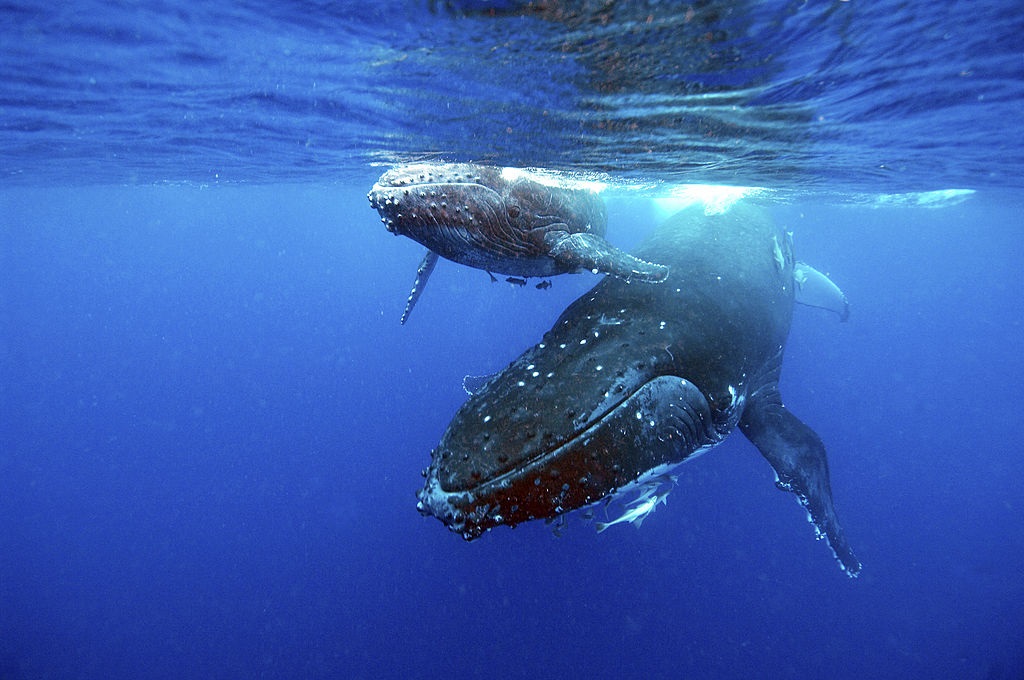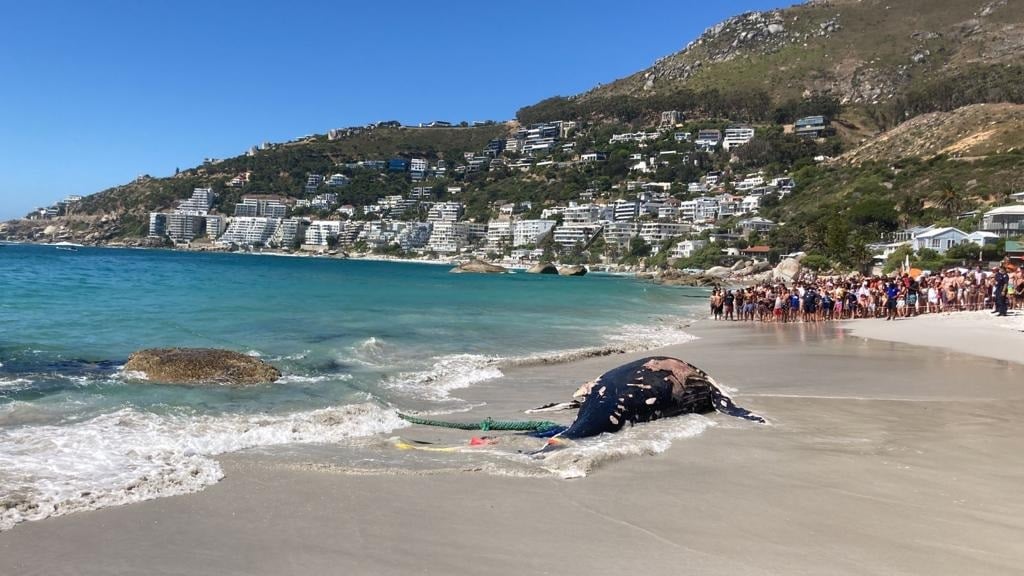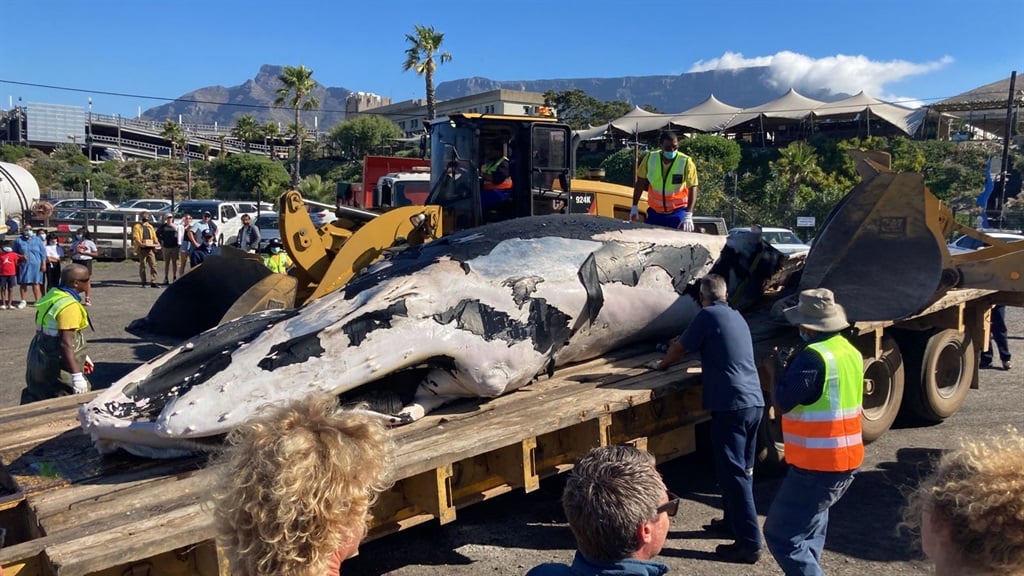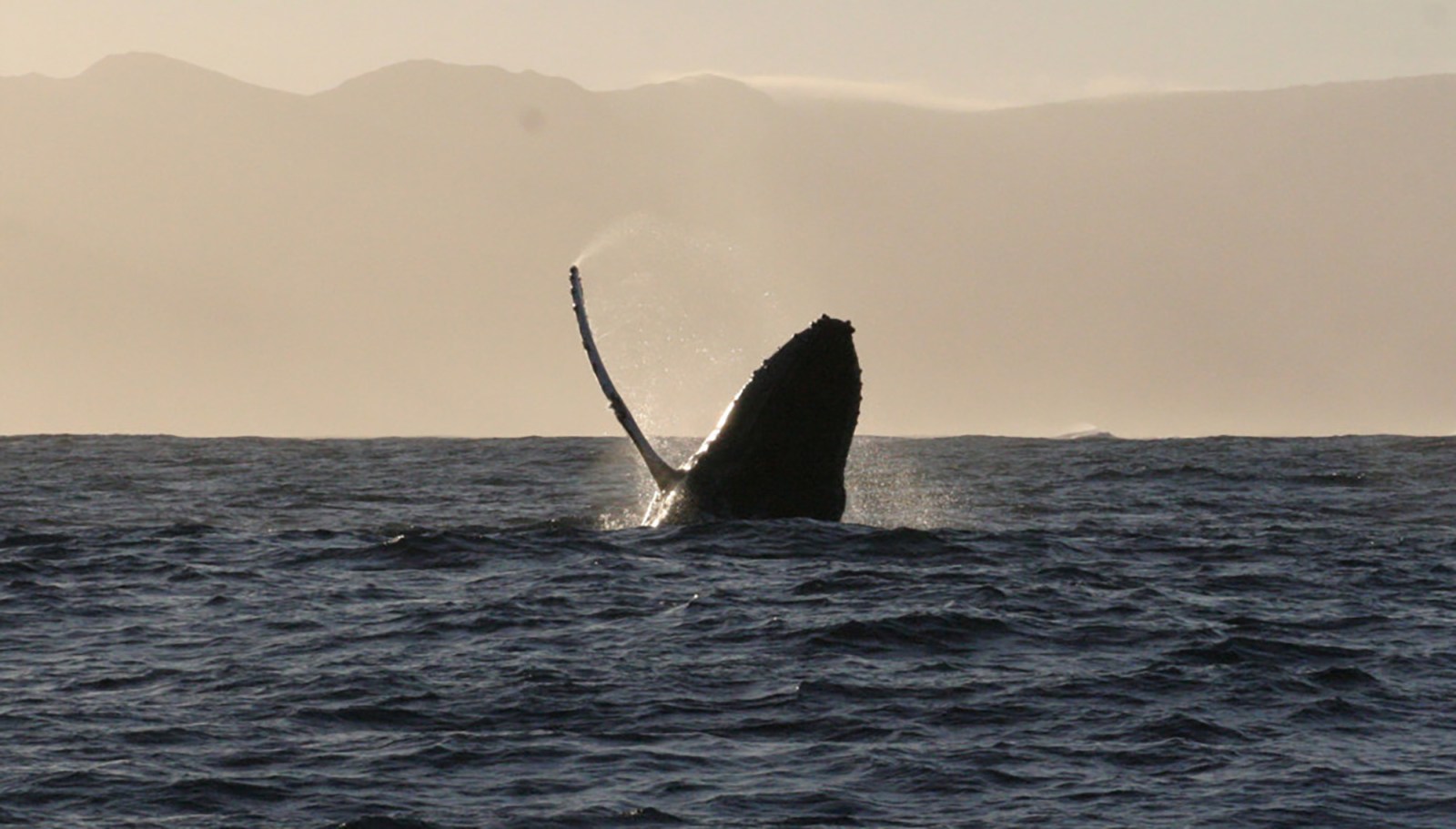By Anke Nel• 16 September 2021
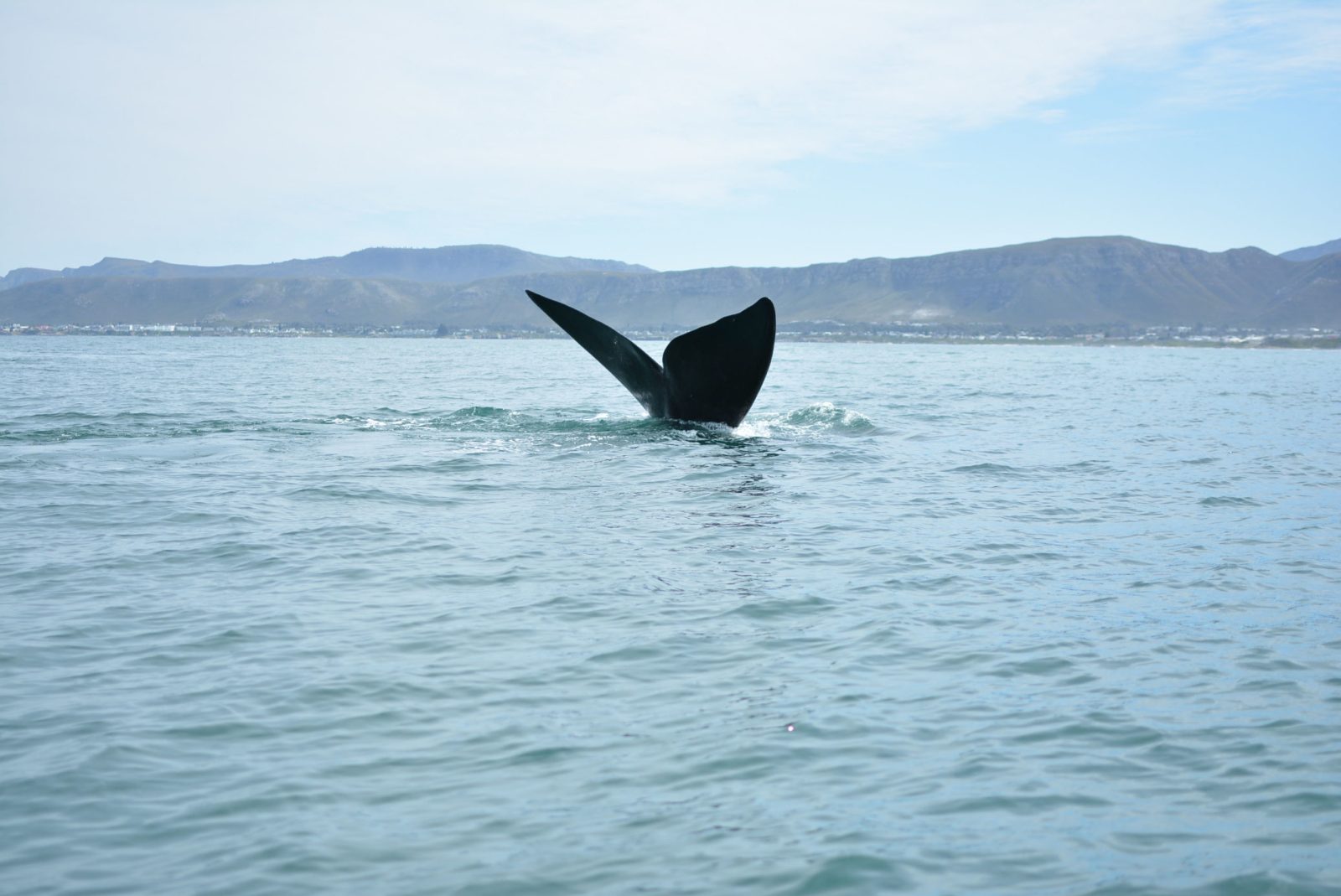
Southern right showing its tail - Hermanus.Photo:Anke Nel
The past decade has marked a drastic decline in the number of southern right whales migrating to South Africa’s coast, and a team of research scientists from the Whale Unit at the University of Pretoria’s Mammal Research Institute are trying to find out why. But, despite lower migration numbers, local businesses in the top whale-watching town of Hermanus are not overly concerned.
Anke Nel is a freelance writer and photographer based in Pretoria covering the environment, conservation and international affairs. She is currently pursuing a Master’s degree at the University of Pretoria (UP) and is an assistant lecturer in the Department of Political Sciences at UP. She writes in her own capacity.
The survival of southern right whales (Eubalaena australis) has, to some extent, always depended on human activities. Wholesale hunting of right whales from the 17th century was so detrimental to population numbers that by 1946 the International Convention for the Regulation of Whaling (now International Whaling Commission) was established to prevent their extinction. The species’ name, “southern right”, in fact, comes from hunters’ belief that they were the “right” whales to hunt, because of their slow and docile nature, because they float when they die, and because they yield large quantities of oil and baleen (a feeding system in their mouths made of keratin — similar to human nails).
Although regulations halting commercial whaling allowed the recovery of right whale populations, indications point to an emerging threat to their foraging success, which is possibly linked to climate change. This ultimately means that fewer right whales have the energy reserves necessary to migrate to the South African coastline.
The town of Hermanus in the Western Cape is considered by the World Wide Fund for Nature (WWF) to be one of the top whale-watching destinations globally, largely due to the whale season from July to November, which offers tourists phenomenal land-based whale watching. Three types of whales can be seen in Hermanus: the humpback whale, the Bryde’s whale and the southern right. The latter is often more enjoyable for observers to watch, because of its calm nature, allowing tourists and whale watchers to experience the species at a closer proximity to the others.

A southern right whale exhales at the start of South Africa’s oldest ocean race, the Mossel Bay Race, in Cape Town on 22 September 2017. (Photo: EPA-EFE/Nic Bothma)
South Africa’s right whale population is now at about 6,116 individuals, increasing at an annual rate of 6.5%. The population is divided into two groups namely, “unaccompanied adults” (male and female adults who do not calve that year) and “cow-calf pairs” (female cows giving birth).
Although oceanic populations are increasing, research scientists from the Whale Unit of the University of Pretoria’s Mammal Research Institute (MRI), are discovering a substantial decrease in the number of right whales migrating to SA’s coastline, as well as an increase in the frequency at which they give birth (known as calving intervals).
Firstly, according to research manager at the MRI Whale Unit, Dr Els Vermeulen, there has been a substantial decrease in the number of unaccompanied adults migrating to our coastline over the last decade, from around 300-400 down to 15-30 animals per year.
Secondly, the number of cow-calf pairs have fluctuated substantially. Since 2015, there was a sharp decline in numbers, followed by a spike in 2018, thereafter numbers declined again.
Thirdly, there has also been an increase in calving intervals. Usually, a female gives birth every three years, but from 2009 this gap increased to four to five years. Lastly, compared to species surveyed in the late 1980s, females giving birth are reportedly about 24% skinnier in recent years, signalling a possible change in diets.
Although the Whale Unit’s research is still ongoing, it believes that this change in foraging strategy is likely the result of a changing climate altering oceanic frontal systems, which are areas of water with a high abundance of prey for whales and other marine species.

Cow-calf pair – Hermanus.Photo:Anke Nel
For example, in the Southern Ocean, Antarctic krill populations are declining and appear to be shifting southward, due to warmer waters in their key habitats. As “capital breeders”, right whales forage on these krill and microscopic zooplankton during the summer months. The food is stored as blubber in their bodies to sustain them through migration to SA’s coastline for the mating and calving season.
Understanding the changing foraging strategies of right whales is not simple. However, with the help of the MRI’s extensive database — considered one of the longest continuous datasets of any marine mammal globally — researchers have access to data from as far back as 1969. This includes, firstly, aerial photographs of right whales, which help to identify individual whales from their callosity patterns (white markings on their head, similar in uniqueness to human fingerprints).

The Whale Unit’s iconic research boat. (Photo: Anke Nel)
Secondly, using stable isotope analysis, which is derived from samples from skin and baleen plates from stranded animals, researchers can compare feeding strategies over time to determine whether right whales have changed what they feed on, and where they feed.
Lastly, a pod of right whales found in the Overberg region will be tagged this year with satellite tags, providing researchers with greater insight into the migration patterns of these whales, as well as their feeding locations.
What do changing migration patterns of southern rights mean for a town like Hermanus?
According to the manager of Cape Coast Tourism, Frieda Lloyd, whale-watching experiences are immensely valuable to local businesses, who all benefit from increased foot traffic in the town. One of the biggest tourist events in Hermanus is the annual Whale Festival, which takes place around the time southern rights return to SA’s coastline. According to data obtained from the Whale Festival Website, the 2019 festival attracted between 90,000 and 100,000 visitors. Said to be one of the largest and most promoted eco festivals in the region, the festival helps to put Hermanus on the map as a preferred tourist destination.
The value the festival brings to the town’s economy is difficult to ignore. Local news sources suggest that the festival assists with promoting Hermanus with multiplatform publicity equating to millions of rands and prioritises locals, with the majority of the vendors originating from the Overberg region; according to 2017 statistics, the festival injected R55-million into the local economy.
Despite the importance of whales to Hermanus’ economy, some local businesses do not seem overly concerned with the decrease in migration numbers. This is possibly because right whales and other species are still present along the coastline and have not completely disappeared, which means businesses are not financially impacted. There are also likely diverging perspectives between business and conservationists, as the former tend to think in the short term, principally, to put food on the table, whereas the latter are more focused on protecting and preserving animal species in the long term.

The Whale Fountain in Hermanus. (Photo: Anke Nel)
Despite the divergent views, it would be a mistake to ignore the research undertaken by the MRI Whale Unit. Southern right whale numbers in Hermanus are dropping — even if the reasons are not yet fully understood — and this may generate socioeconomic consequences down the line. More importantly, ignoring the science may hamper conservation efforts, which could lead to a further decline of right whales along SA’s coast. This decline will not be as easily reversible as the regulation of whale hunting was almost a century ago. DM/OBP
To learn more about the research undertaken by the whale unit visit www.adoptawhale.co.za. You can also opt to “adopt a whale” symbolically to help fund whale conservation by covering some of the costs associated with their fieldwork.




